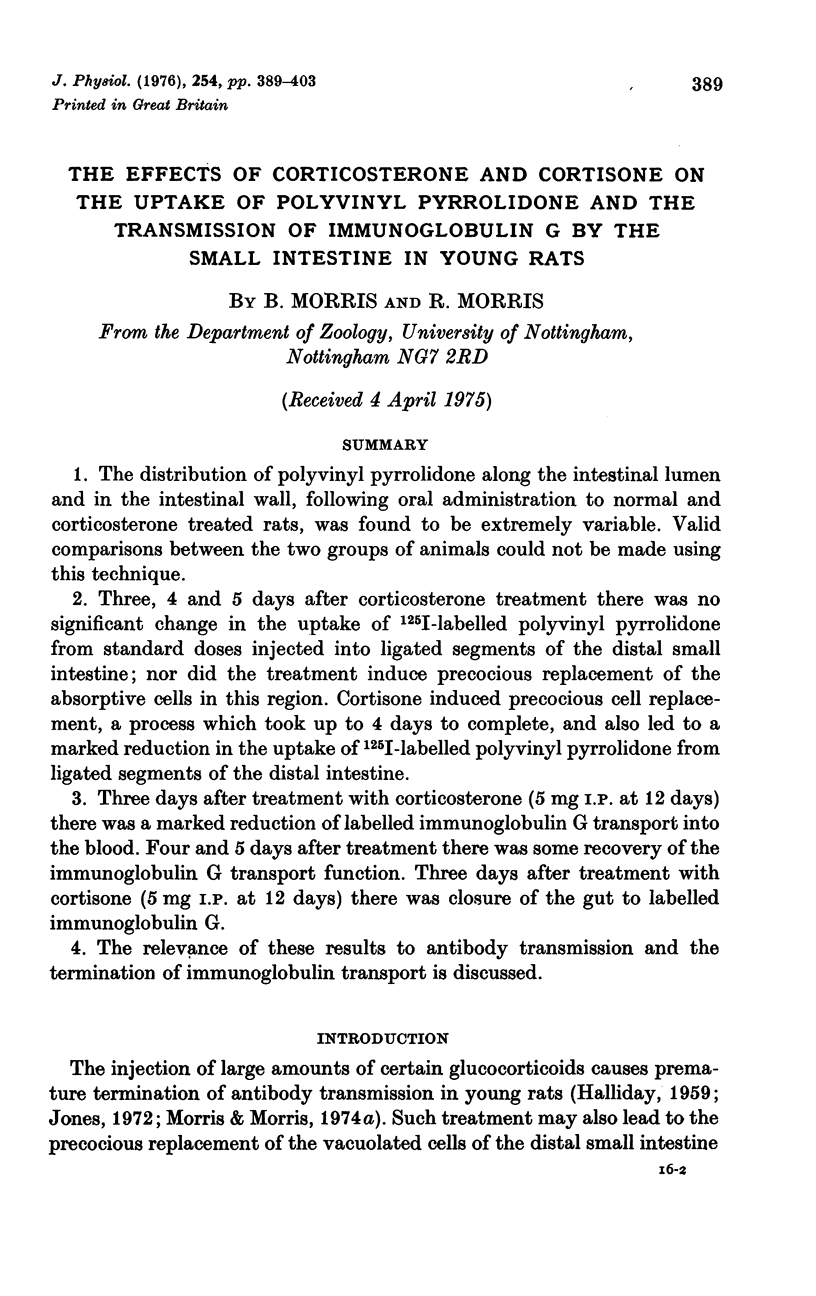Abstract
1. The distribution of polyvinyl pyrrolidone along the intestinal lumen and in the intestinal wall, following oral administration to normal and corticosterone treated rats, was found to be extremely variable. Valid comparisons between the two groups of animals could not be made using this technique. 2. Three, 4 and 5 days after corticosterone treatment there was no significant change in the uptake of 125I-labelled polyvinyl pyrrolidone from standard doses injected into ligated segments of the distal small intestine; nor did the treatment induce precocious replacement of the absorptive cells in this region. Cortisone induced precocious cell replacement, a process which took up to 4 days to complete, and also led to a marked reduction in the uptake of 125I-labelled polyvinyl pyrrolidone from ligated segments of the distal intestine. 3. Three days after treatment with corticosterone (5 mg I.P. at 12 days) there was a marked reduction of labelled immunoglobulin G transport into the blood. Four and 5 days after treatment there was some recovery of the immunoglobulin G transport function. Three days after treatment with cortisone (5 mg I.P. at 12 days) there was closure of the gut to labelled immunoglobulin G. 4. The relevance of these results to antibody transmission and the termination of immunoglobulin transport is discussed.
Full text
PDF














Selected References
These references are in PubMed. This may not be the complete list of references from this article.
- Clarke R. M., Hardy R. N. An analysis of the mechanism of cessation of uptake of macromolecular substances by the intestine of the young rat ('closure'). J Physiol. 1969 Sep;204(1):127–134. doi: 10.1113/jphysiol.1969.sp008903. [DOI] [PMC free article] [PubMed] [Google Scholar]
- Clarke R. M., Hardy R. N. The use of [125-I] polyvinyl pyrrolidone K. 60 in the quantitative assessment of the uptake of macromolecular substances by the intestine of the young rat. J Physiol. 1969 Sep;204(1):113–125. doi: 10.1113/jphysiol.1969.sp008902. [DOI] [PMC free article] [PubMed] [Google Scholar]
- Daniels V. G., Hardy R. N., Malinowska K. W., Nathanielsz P. W. Adrenocortical hormones and absorption of macromolecules by the small intestine of the young rat. J Endocrinol. 1972 Feb;52(2):405–406. doi: 10.1677/joe.0.0520405. [DOI] [PubMed] [Google Scholar]
- Daniels V. G., Hardy R. N., Malinowska K. W., Nathanielsz P. W. The influence of exogenous steroids on macromolecule uptake by the small intestine of the new-born rat. J Physiol. 1973 Mar;229(3):681–695. doi: 10.1113/jphysiol.1973.sp010160. [DOI] [PMC free article] [PubMed] [Google Scholar]
- Daniels V. G., Hardy R. N., Malinowska K. W. The effect of adrenalectomy or pharmacological inhibition of adrenocortical function on macromolecule uptake by the new-born rat intestine. J Physiol. 1973 Mar;229(3):697–707. doi: 10.1113/jphysiol.1973.sp010161. [DOI] [PMC free article] [PubMed] [Google Scholar]
- HALLIDAY R. The effect of steroid hormones on the absorption of antibody by the young rat. J Endocrinol. 1959 Jan;18(1):56–66. doi: 10.1677/joe.0.0180056. [DOI] [PubMed] [Google Scholar]
- Jones E. A., Waldmann T. A. The mechanism of intestinal uptake and transcellular transport of IgG in the neonatal rat. J Clin Invest. 1972 Nov;51(11):2916–2927. doi: 10.1172/JCI107116. [DOI] [PMC free article] [PubMed] [Google Scholar]
- Jones R. E. Intestinal absorption and gastro-intestinal digestion of protein in the young rat during the normal and cortisone-induced post-closure period. Biochim Biophys Acta. 1972 Aug 9;274(2):412–419. doi: 10.1016/0005-2736(72)90187-3. [DOI] [PubMed] [Google Scholar]
- Morris B., Morris R. The absorption of 125I-labelled immunoglobulin G by different regions of the gut in young rats. J Physiol. 1974 Sep;241(3):761–770. doi: 10.1113/jphysiol.1974.sp010683. [DOI] [PMC free article] [PubMed] [Google Scholar]
- Morris B., Morris R. The effects of cortisone acetate on stomach evacuation and the absorption of 125I-labelled globulins in young rats. J Physiol. 1974 Jul;240(1):79–89. doi: 10.1113/jphysiol.1974.sp010600. [DOI] [PMC free article] [PubMed] [Google Scholar]
- Morris B. The transmission of -125-I-labelled immunoglobulin G by proximal and distal regions of the small intestine of 16-day-old rats. J Physiol. 1975 Feb;245(1):249–259. doi: 10.1113/jphysiol.1975.sp010843. [DOI] [PMC free article] [PubMed] [Google Scholar]
- Rodewald R. Intestinal transport of antibodies in the newborn rat. J Cell Biol. 1973 Jul;58(1):189–211. doi: 10.1083/jcb.58.1.189. [DOI] [PMC free article] [PubMed] [Google Scholar]
- Rosa U., Pennisi F., Bianchi R., Federighi G., Donato L. Chemical and biological effects of iodination on human albumin. Biochim Biophys Acta. 1967 Apr 11;133(3):486–498. doi: 10.1016/0005-2795(67)90553-3. [DOI] [PubMed] [Google Scholar]
- Waldmann T. A., Jones E. A. The role of cell-surface receptors in the transport and catabolism of immunoglobulins. Ciba Found Symp. 1972;9:5–23. doi: 10.1002/9780470719923.ch2. [DOI] [PubMed] [Google Scholar]


